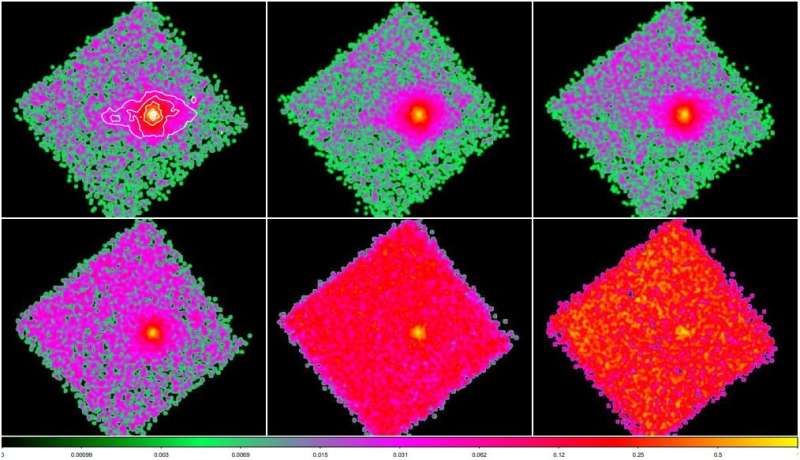April 23, 2019 report
X-ray observations reveal insights into the nature of the pulsar wind nebula 3C 58

Analysis of the new data from X-ray observations using NASA's NuSTAR spacecraft and archival data from the agency's Chandra X-ray space observatory, has yielded more insights into the nature of a pulsar wind nebula (PWN) named 3C 58. Results of the analysis, presented in a paper published April 12 on arXiv.org, could also shed more light on particle distribution in the population of known PWNe.
PWNe are nebulae powered by the wind of a pulsar. Pulsar wind is composed of charged particles and when it collides with the pulsar's surroundings, in particular with the slowly expanding supernova ejecta, it develops a PWN.
Observations of PWNe have shown that the particles in these objects lose their energy to radiation and become less energetic with distance from the central pulsar. In particular, X-ray studies of PWNe, especially using spatially-integrated spectra in the X-ray band, have the potential of uncovering important information about particle flow in these nebulae.
Located some 6,500 to 10,000 light years away from the Earth, 3C 58 is a young PWN with torus-jet structure and powered by the 65-milisecond pulsar PSR J0205+6449. While the object has been intensively studied in the soft X-ray band (below 8.0 keV) and hence its soft X-ray spectrum is well modeled, astronomers are interested in verifying if the spectrum extends to hard X-ray band above 10 keV.
In order to check this, a group of researchers led by Hongjun An of Chungbuk National University in Cheongju, South Korea employed the Nuclear Spectroscopic Telescope Array (NuSTAR) spacecraft to perform spectral analysis of 3C 58 up to 20 keV. They also reanalyzed the Chandra data for comparison with results from NuSTAR.
The astronomers measured the energy-dependent morphology, spatial variation of the spectral index, and a spatially integrated broadband X-ray spectrum of 3C 58.
"These measurements are used to infer properties of 3C 58 with synchrotron-radiation scenarios," the researchers wrote in the paper.
The results indicate that the size of the 3C 58 decreases with increasing energy, what, according to the researchers is due to the synchrotron burn-off effect. The data also show that the spectrum is softer in outer regions of this PWN.
Moreover, the researchers found a hint of a spectral break in the spatially integrated X-ray spectrum and a break in the radial profile of the spectral index of 3C 58.
"The radial profile of the spectral index breaks at R ≈ 80, and the spatially integrated X-ray spectrum of 3C 58 shows a hint of a spectral break at ≈ 25 keV," the paper reads.
According to the study, the break in the radial profile indicates a maximum electron energy of about 200 TeV, what is larger than previously estimated. When it comes to the spectral break, the data suggests a maximum electron energy of approximately 140 TeV for an assumed magnetic field strength of 80 μG. Additionally, the strength of the magnetic field in 3C 58 was calculated to be between 30 and 200 μG.
All in all, the astronomers concluded that their study could advance our knowledge about acceleration and emission models of PWNe. They noted that in the case of 3C 58, its well measured broadband spectral energy distribution and the possible X-ray break, have the potential to provide new insights into particle acceleration and flow in PWNe.
More information: Hongjun An. NuSTAR hard X-ray studies of the pulsar wind nebula 3C~58. arXiv:1904.05991 [astro-ph.HE]. arxiv.org/abs/1904.05991
© 2019 Science X Network





















